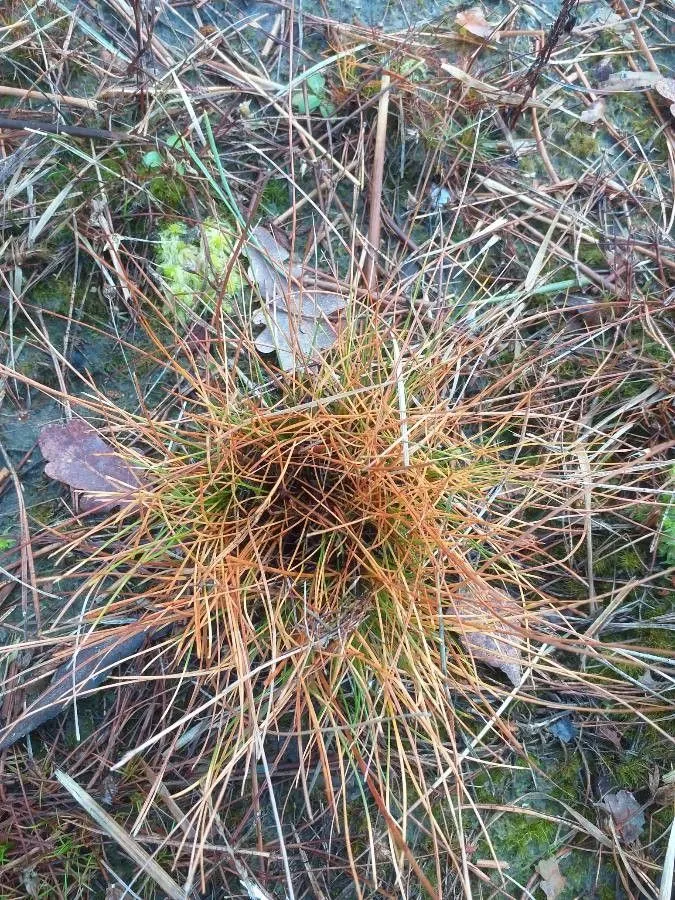
Author: (Sm.) Desv.
Bibliography: Observ. Pl. Angers: 74 (1818)
Year: 1818
Status: accepted
Rank: species
Genus: Eleocharis
Vegetable: False
Observations: Macaronesia, Europe to N. Africa
Many-stalked spike-rush, known scientifically as Eleocharis multicaulis, is a perennial plant belonging to the Cyperaceae family. First described by the botanist Desv. in his 1818 work “Observations on the Plants of Angers,” this distinctive plant species is noted for its widespread presence across diverse geographical regions including Macaronesia, Europe, and North Africa.
Characterized by its numerous slender stalks that arise from a network of creeping rhizomes, Many-stalked spike-rush typically thrives in wetlands, marshes, and along the edges of bodies of water. The plant exhibits fine, grass-like foliage and produces small, inconspicuous flowers grouped in spikelets, which are often positioned at the tip of each stalk. These spikelets, integral to the plant’s reproductive cycle, facilitate the spread of seeds through wind and water dispersal methods.
The adaptability of Eleocharis multicaulis to both temperate and mild climatic conditions underscores its ecological significance, particularly in maintaining wetland habitats and supporting a variety of wildlife. Due to its propensity to grow in saturated soils, this spike-rush plays a critical role in soil stabilization and water filtration, contributing to the health and biodiversity of these ecosystems.
Botanists and ecologists study Eleocharis multicaulis not only for its ecological contributions but also for its potential use in environmental restoration projects. Its resilience and natural affinity for moist environments make it a valuable species in efforts to rehabilitate degraded wetlands and prevent soil erosion.
In summary, Many-stalked spike-rush (Eleocharis multicaulis) stands as a vital component of wetland ecosystems across Macaronesia, Europe, and North Africa. Its presence not only supports environmental health but also enhances biodiversity and offers promising avenues for ecological restoration.
Dan: mangestænglet sumpstrå
Deu: vielstengelige sumpfbinse
Lav: daudzstublaju pameldrs
Pol: poniklo wielolodygowe
Eng: many-stalked spike-rush, many-stemmed spike-rush
Swe: dysäv
Cym: clwpfrwynen galafog, sbigfrwynen gadeiriog, ysbigfrwyn cadeiriog, ysbigfrwynen gadeiriog
En: Many-stalked Spike-rush, Many-Stemmed Spike-Rush
Da: Mangestænglet sumpstrå
Nl: Veelstengelige Waterbies
Fi: Liejuluikka
Fr: Scirpe à nombreuses tiges, Souchet à tiges nombreuses
De: Vielstengelige Sumpfbinse, Vielstengelige Sumpfsimse
It: Giunchina cespugliosa, Giunchina cespugliose
Lv: Daudzstublaju pameldrs
Pl: Poniklo wielolodygowe
Sv: Dysäv
Cy: Clwpfrwynen Galafog, Sbigfrwynen Gadeiriog, Ysbigfrwyn Cadeiriog, Ysbigfrwynen Gadeiriog
: Many-stalked spike-rush
© copyright of the Board of Trustees of the Royal Botanic Gardens, Kew.
Taken Jul 15, 2012 by Photoflora – Jean-Luc TASSET (©)
Taken Jul 15, 2012 by Photoflora – Jean-Luc TASSET (©)
Taken May 16, 2016 by Tela Botanica − Section locale de la SBF ABBA – ASSOCIATION BOTANIQUE (cc-by-sa)
Taken Dec 31, 2020 by Maarten Vanhove (cc-by-sa)
Taken Jun 20, 2016 by Tela Botanica − Genevieve BOTTI (cc-by-sa)
Taken May 24, 2021 by Patrick Nard (cc-by-sa)
Taken May 22, 2019 by Mariella Van Gemeren (cc-by-sa)
Taken Jul 15, 2012 by Photoflora – Jean-Luc TASSET (©)
Taken May 16, 2016 by Tela Botanica − Section locale de la SBF ABBA – ASSOCIATION BOTANIQUE (cc-by-sa)
Taken Aug 8, 2018 by Tela Botanica − Florent Beck (cc-by-sa)
Taken May 19, 2022 by Simon Flippo (cc-by-sa)
Taken Jul 23, 2022 by Tsuga Identification (cc-by-sa)
Taken Aug 16, 2020 by Raj (cc-by-sa)
Taken Jul 23, 2022 by Tsuga Identification (cc-by-sa)
Taken Jul 15, 1996 by Photoflora – Benoit BOCK (©)
Taken May 23, 2015 by Tela Botanica − Gérard LEVESLIN (cc-by-sa)
Taken May 15, 2007 by Photoflora – Yann QUELEN (©)
Taken May 15, 2007 by Photoflora – Yann QUELEN (©)
Taken Jan 1, 1970 by Photoflora – L’Abbé COSTE (©)
Taken Jul 30, 2012 by Tela Botanica − David MERCIER (cc-by-sa)
Ph maximum: 5.5
Ph minimum: 5.0
Light: 8
Atmospheric humidity: 9
Bloom months: [‘jun’, ‘jul’, ‘aug’]
Soil nutriments: 3
Soil salinity: 1
Family: Myrtaceae Author: (F.Muell.) K.D.Hill & L.A.S.Johnson Bibliography: Telopea 6: 402 (1995) Year: 1995 Status:…
Family: Rubiaceae Author: Pierre ex A.Froehner Bibliography: Notizbl. Bot. Gart. Berlin-Dahlem 1: 237 (1897) Year:…
Family: Sapindaceae Author: Koidz. Bibliography: J. Coll. Sci. Imp. Univ. Tokyo 32(1): 38 (1911) Year:…
Family: Asteraceae Author: A.Gray Bibliography: Pacif. Railr. Rep.: 107 (1857) Year: 1857 Status: accepted Rank:…
Family: Fabaceae Author: Medik. Bibliography: Vorles. Churpfälz. Phys.-Ökon. Ges. 2: 398 (1787) Year: 1787 Status:…
Family: Aspleniaceae Author: (Cav.) Alston Bibliography: Bull. Misc. Inform. Kew 1932: 309 (1932) Year: 1932…